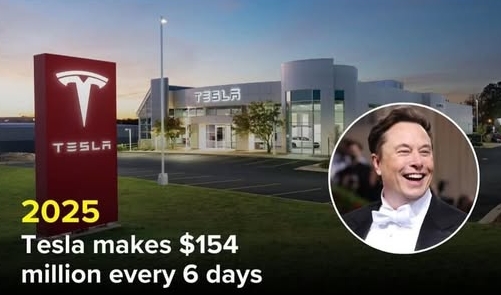
In 2010, Tesla teetered on the brink of collapse. The electric vehicle (EV) company, led by a determined yet embattled Elon Musk, faced an uncertain future, losing $154 million that year. The skepticism surrounding Tesla was immense—critics dismissed it as a pipe dream, investors were reluctant to back it, and traditional automakers saw it as an insignificant player. The challenges were overwhelming, but Musk was undeterred.
Elon Musk had already poured his personal fortune into Tesla, risking bankruptcy and sleepless nights to keep the company afloat. In a desperate bid to save the company, Tesla secured a $465 million loan from the U.S. Department of Energy. This lifeline, combined with a successful IPO in June 2010 that raised $226 million, provided Tesla with the breathing room it desperately needed.
However, financial survival was only the first hurdle. To thrive, Tesla had to prove its technology was viable and capable of competing with gasoline-powered cars. The breakthrough came in 2012 with the launch of the Model S. It was not just an electric car—it was a statement of luxury, performance, and innovation. With industry-leading range, cutting-edge software, and a sleek design, the Model S silenced many critics and won accolades, including Motor Trend’s Car of the Year.
Tesla’s growth was not just about making better cars; it was about revolutionizing an industry. The company expanded its Supercharger network, solving one of the biggest concerns about EVs: charging infrastructure. It also pioneered over-the-air software updates, making Tesla vehicles the first cars to improve over time without needing to visit a dealership. These innovations, coupled with Musk’s ability to inspire both consumers and investors, propelled Tesla forward.
By the mid-2010s, Tesla was scaling rapidly. The introduction of the Model X SUV in 2015 and the mass-market Model 3 in 2017 fueled unprecedented demand. But the road was far from smooth. Tesla’s “production hell” in 2018, as Musk called it, nearly derailed the company. Struggling to meet demand and facing intense scrutiny from investors, Tesla’s stock fluctuated wildly. Yet, against all odds, Musk pushed through. By 2020, Tesla had become the world’s most valuable automaker, surpassing industry giants like Toyota and Volkswagen.
Fast forward to 2025, and Tesla’s transformation is almost unimaginable. The once-struggling startup now earns $154 million every six days. Its market capitalization has soared into the hundreds of billions, and its influence stretches beyond cars, with ventures in solar energy, AI, and robotics. Tesla’s showrooms stand as monuments to Musk’s vision, and its cutting-edge technology continues to shape the future of transportation.
What made this turnaround possible? Was it sheer genius, relentless perseverance, or a perfect mix of both? Perhaps it was Musk’s unwavering belief in Tesla’s mission that ultimately turned skeptics into believers. Regardless of the reasons, one thing is undeniable: Tesla’s journey from near bankruptcy to industry dominance is one of the greatest business transformations in history. And with Musk at the helm, the story is far from over.
Hello, everybody! Welcome back to the Space News Pod, your go-to show for all things SpaceX, NASA, and space flight. I’m your host, Will Walden, and in this episode, we have breaking news regarding SpaceX’s highly anticipated Starship flight 7, which has now been postponed.
Originally, the launch of Starship was scheduled for January 11th, with a backup date set for January 12th. However, it looks like those dates are no longer in play. The team at SpaceX has decided to delay the launch, and now we’re looking at a new potential launch window.
Before we dive deeper into the reasons behind the delay, let’s take a look at the weather forecast. While the weather is usually a key factor in any rocket launch, it seems that Mother Nature is also playing a part in the postponement. For the days leading up to the 10th, we can expect some showers, with Wednesday and Thursday both forecasted to have significant rainfall. While Friday, January 10th, sees only a slight chance of showers, the 11th and 12th have a much better forecast, with mostly sunny skies and light winds.
Now, let’s dive into the key reason behind the delay. SpaceX is in the process of transporting Starship and other equipment to the launch site. On the night of January 8th and into the early hours of January 9th, a temporary road closure will take place along the Boca Chica Beach Highway 4 to allow for the transport of critical components from the factory to the launch pad. This process will take several days to complete, and it’s crucial for SpaceX to get everything in position before they proceed with the flight.

Furthermore, it seems that SpaceX will be testing the system before the launch, which adds to the time needed. According to Elon Musk, the delay isn’t long-term—SpaceX is simply looking at a new launch window sometime next week, with January 14th now being the latest possible date for liftoff. This means we could see Starship Flight 7 either on Monday, January 13th, or Tuesday, January 14th, depending on how everything aligns.
Despite the delays, this is still exciting news for the space community. A flawless launch is paramount for SpaceX, and they want to ensure everything, including booster recovery, goes smoothly. The winds on the ground and in the air need to align perfectly to ensure the booster can be caught by the “Chopsticks” on Mechazilla, a critical part of the landing process.
As of now, we’re all waiting to see if the weather clears up enough for the launch to happen early next week. Elon Musk himself has confirmed the delay is just a short one, and it’s definitely not the end of the world.
What do you think about the postponement? Do you think the weather will cooperate for a January 13th or 14th launch? Let us know in the comments below! And, as always, if you’re enjoying the content, please leave a like and subscribe for more updates.
That’s all for today’s update on Starship Flight 7! Stay tuned, and we’ll keep you posted as we get closer to the big day.



